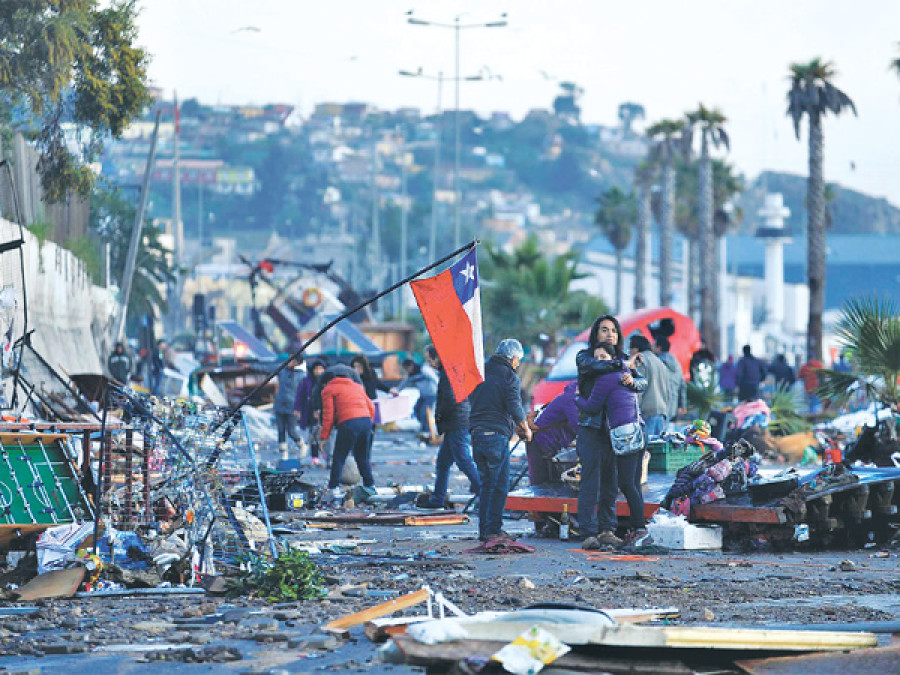Opinion
Tale of two quakes
The delay in passing the reconstruction bill shows that our leaders are not serious about rebuilding Nepal
Gyanendra Gurung
When the Finance Minister recently reassured the public that the government will be adopting the reconstruction policy soon, the question on everyone’s mind was, “How ‘soon’ is soon?”
While the nation splurged on ostentatious display of fireworks to mark the promulgation of the new constitution on September 20, the future of the earthquake-ravaged country folks remained dark as ever. Even the ceremonious candles lit during the historic event seemed funeralesque, as if insinuating the death of the aspirations that the earthquake victims once held. Not even a powerful quake, halfway across the globe in the coastal city of Illapel, Chile in the week preceding the promulgation of our long-overdue statute could serve as a reminder to our duplicitous leaders of the recent quake in Nepal, nor could it trigger a sense of urgency in them. Have they already forgotten that Nepal has a familiar disaster to tend to and make preparations for the next one?
Strict codes
The 8.3 magnitude temblor which rocked Chile on September 17, was approximately five times more stronger than the quake that we experienced on April 25 and yet, the devastation caused by the two seismic events was highly disproportionate. Wedged between the Andes mountain in the east and the Pacific Ocean in the west, Chile is no stranger to earthquakes. Its history is riddled with a greater frequency of earthquakes that are more destructive than ours. However, the good people of Chile have learnt too many tragic lessons in the past and have left no stones unturned by instituting stringent building codes for earthquake protection and earthquake awareness programmes for the public. And, with every new earthquake, their preparedness is put to the test and the results are exemplary.
But of course, it was not always like that. In 1960, when an earthquake 350 times more powerful than the Gorkha temblor struck Valvidia in southern Chile, thousands were killed and millions left homeless. It was one of the deadliest earthquake ever recorded by modern instruments; a staggering magnitude of 9.5. It set off a wave of destructive tsunamis from California to Japan, unleashing terror in coastal cities across the Pacific Ocean. And as the world witnessed the images of the devastation, it sent a clear message to Chile and other quake-threatened cities around the globe to enforce and toughen their building codes.
Here in Nepal, we too have had building codes for more than 20 years, and soon they will be getting a boost from the recently approved ‘Basic Guideline on Settlement Development, Urban Planning Building Construction 2015’. While it is great that our officials are finally pushing for some tough regulations for an earthquake-safe society, it is quite tragic that we had to wait for a catastrophe to be serious about it. But, will the new updated codes really protect us? As experts have already noted, as long as we do not take any steps to improve accountability, oversight, and strict enforcement of safe practices, citizens will remain just as vulnerable as before.
And what about the stone-and-mud houses in the villages? Who is making guidelines for the village houses and schools that desperately need to be rebuild? I guess not, but the closest thing to any regulations for the countryside, could come in the form of the government’s ambitious plan of training more than 50,000 youths on masonry works. While it is important that the selected ‘youths’ actually come from the affected villages, it is equally imperative that the trainings pay heed to their own ‘local’ skills as well. Since most of the villagers build their houses by themselves, training either an outsider or disrespecting their indigenous knowledge can be disastrous. Also, it is important to promote numerous low-cost, low-skilled and culturally-appropriate technologies such as earthbagging or the ‘Gabion band’ method—recently developed by Randolph Langenbach for the Mountain Fund—in these trainings.
Mexican tragedy
For many years, the weak implementation of building codes and the absence of any concrete urban planning strategies in the Capital always had our experts worrying. A cataclysmic scenario in the Capital had been predicted in case of a massive quake. Yet, Kathmandu got lucky this time. But had the grounds rolled and rumbled as per scientific expectations, it could have met a fate far worse than that of Mexico City three decades ago.
In the early morning of September 19, 1985, while the city was asleep, an earthquake of 8 magnitude—twice as strong as the Gorkha earthquake—killed thousands of people in Mexico City. Despite the epicenter being more than 300 km away from the city, the city shook so violently that it sent more than hundred thousand buildings crumbling down. Built on top of a lake bed, the soil conditions of Mexico city are similar to that of Kathmandu, ie, notoriously susceptible to high shaking and liquefaction during an earthquake.
The Mexico City which recently commemorated the 30th anniversary of the 1985 earthquake is a different city. The scars of its tragic past are nowhere to be found. In the wake of the tragedy, the Mexican government, similar to Chile’s, also implemented rigorous seismic building codes for the city. But, while the protocol was strictly enforced in the city, it is still ‘irrelevant’ and unregulated in its periphery, as recently reported in The Guardian. This is an all-too-common problem, ie, negligence of building codes increases in areas farther away from the centre.Thus, we have to ensure that our own enthusiasm for the strict enforcement of our newly-revised codes do not succumb to similar neglect. For that to happen, city authorities must immediately put up a decree halting further haphazard urban expansion in the fringes of the city, especially on risky land.
Social quake
While the 1985 Mexican earthquake sparked a “social earthquake” awaking “centuries of civic lethargy”, as Homero Aridjis, a Mexican poet and environmentalist recently wrote, ours on the other hand, has sadly steered us off towards unnecessary distractions, erasing the plight of the earthquake victims from our memory. By pushing the reconstruction bill to the backseat, our disingenuous leaders have not only failed to express any seriousness in rebuilding this nation, but also exposed the fact that the greatest vulnerability that we currently face today are beyond the realms of the physical or geo-environmental. And, if we fail to address these social and political issues at hand, not only will it choke the reconstruction process, but also drain the hopes and aspirations for a greater and safer Nepal.
Gurung is a Post-doctoral Research Fellow at Chonbuk National University, Jeonju, South Korea




 21.12°C Kathmandu
21.12°C Kathmandu










